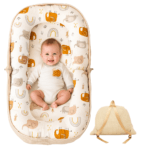Navigating the world of baby nutrition can feel like embarking on a delicious yet complex journey. As parents, we strive to make choices that not only tantalize our little one’s taste buds but also nurture their growing bodies. One common query in this culinary adventure is, “Can babies have Honey Nut Cheerios?”
In this exploration, we aim to unravel the sweet truth behind this crunchy dilemma, considering both the joys of introducing solid foods and the vital importance of ensuring our choices align with the well-being of our precious bundles of joy. So, fasten your seatbelts, and let’s embark on a flavorful journey to discover whether Honey Nut Cheerios cut the symphony of a baby’s culinary crescendo.
About Nutritional Needs for Infants
Introducing solid BABY foods is a pivotal phase in a baby’s development, marking a transition from exclusive reliance on milk to a more diversified diet. This milestone typically occurs around six months, aligning with when many babies start showing signs of readiness, such as increased curiosity about food, improved head control, and the ability to sit with support.
Beyond the excitement of witnessing your little one embark on this culinary adventure, it’s essential to recognize solid foods’ profound impact on their overall growth and well-being. The choices made during this period can lay the foundation for a lifetime of healthy eating habits.
The Beginning of Solid Foods
The introduction of solid foods signifies more than just a shift in the texture of meals. It explores a broader spectrum of tastes, textures, and nutrients, contributing to a well-rounded diet. Parents are responsible for making this journey enjoyable and ensuring that the growing infant’s nutritional needs to met.
The Importance of Iron
Iron, a powerhouse nutrient, takes center stage in the nutritional requirements of infants during the introduction of solid foods. This mineral plays a crucial role in supporting cognitive development, aiding hemoglobin formation, and promoting optimal physical growth. As babies are born with a finite store of iron that depletes over time, introducing iron-rich foods becomes paramount to prevent deficiencies that could impact their developmental milestones.
Read to know more: Can Babies Have Maple Syrup? Sweet Beginnings
The Honey Nut Cheerios Dilemma

Analyzing the Ingredients
Honey Nut Cheerios, adorned with their delightful blend of honey and nuts, are tempting for a snack, even for the tiniest taste buds. However, beneath the surface of this seemingly innocent cereal lies a dilemma – the inclusion of honey, a potential concern for infants.
Delving into the ingredients, we find that honey, a natural sweetener, is risky for babies under one year old. The concern stems from the potential presence of Clostridium botulinum spores, which can lead to infant botulism, a rare but severe illness. This revelation prompts parents to ponder the safety of introducing such a delectable treat to their little ones.
Can Babies Consume Honey?
The American Academy of Pediatrics takes a firm stance, advising against giving honey to infants under one. This precautionary measure aims to mitigate the risk of botulism, emphasizing the vulnerability of a baby’s underdeveloped digestive system to potential toxins.

Yet, the lingering question remains – what about the minimal amount of honey found in Honey Nut Cheerios? This difficulty underscores the delicate balance parents must strike between introducing diverse flavors and safeguarding their baby’s health.
Consultation with Pediatricians
Amidst the Honey Nut Cheerios problem, the wisest path emerges: consult with your pediatrician. These healthcare professionals serve as invaluable guides, offering personalized advice tailored to your baby’s unique health and developmental needs.
Before embarking on the journey of introducing new foods, especially those with potential allergens like honey, seek the expertise of your pediatrician. Their insight ensures you make informed decisions aligned with your baby’s well-being.
Exploring Alternatives
Nutritious Alternatives for Babies
Should the Honey Nut Cheerios fall under the “proceed with caution” category, fear not. Numerous alternatives exist that cater to your baby’s taste buds and contribute to their overall well-being.
Explore a world of nutritious alternatives, from plain Cheerios to other baby-friendly snacks. These options provide a spectrum of flavors and textures, allowing your little one to experience the joy of diverse tastes without compromising their health.
Making Informed Decisions
Reading Labels Carefully
Knowledge emerges as a formidable ally in the intricate landscape of baby nutrition. Understanding how to decipher food labels empowers parents to make informed choices that align with their baby’s dietary needs.
As you navigate the supermarket’s aisles, pay close attention to ingredient lists and nutritional information. This diligence ensures that each choice contributes positively to your baby’s health and development.
Homemade Cereal Options
For the hands-on parents who relish crafting culinary delights for their little ones, homemade cereals stand out as a wholesome and customizable alternative to store-bought options. By blending grains like rice or oats, you control the ingredients and cater to your baby’s evolving palate.
In baby nutrition, the Honey Nut Cheerios dilemma unveils a broader narrative – the delicate balance between taste exploration and health consciousness. Whether through careful label scrutiny, consultation with pediatricians, or the joy of crafting homemade delights, parents embark on a journey of making informed decisions that shape their baby’s budding relationship with food.
At What Age Can Babies Have Honey Nut Cheerios?

Introducing Honey Nut Cheerios to your baby requires careful consideration of their age and developmental stage. Pediatricians generally advise against raising honey, a key ingredient in Honey Nut Cheerios, to infants under one year old. This precaution is due to the risk of infant botulism, a rare but severe illness. The immature digestive system of babies under one is more susceptible to the bacteria that can be present in honey.
As a parent, adhering to these guidelines and waiting until your baby reaches the recommended age before incorporating Honey Nut Cheerios into their diet is crucial. Prioritizing your baby’s safety and well-being during this critical stage of development is paramount.
What If I Gave My Baby Honey Nut Cheerios?
If you’ve inadvertently given your baby Honey Nut Cheerios before they turn one, don’t panic. Monitor your baby for any signs of discomfort or unusual behavior. Symptoms of infant botulism can include constipation, weak crying, and difficulty feeding. If you notice any concerning signs, seek immediate medical attention.
However, if your baby shows no adverse reactions, it’s still advisable to consult with your pediatrician. They can provide personalized advice based on your baby’s health and guide you on the best action.
Why Are Cheerios Safe for Babies?
Cheerios are generally considered safe for babies in their original form without added honey or nuts. The absence of love eliminates the risk of botulism associated with the consumption of honey by infants. Plain Cheerios are often recommended as one of the first finger foods for babies, making them a popular choice for parents introducing solids.
The small size, easy-to-dissolve texture, and low risk of allergens make plain Cheerios a suitable snack option for babies who have started on solids. As always, it’s essential to supervise your baby during feeding and ensure they can handle the texture of the cereal.
Navigating Parental Concerns
Navigating parental concerns in the realm of introducing solid foods, especially when it comes to potentially allergenic options like Honey Nut Cheerios, involves addressing key points to ensure the well-being of your little one. Here’s a breakdown:
Addressing Worries and Misconceptions
Parents often grapple with worries and misconceptions surrounding the introduction of new foods, particularly those containing honey. It’s crucial to acknowledge these concerns and provide reassurance, emphasizing the importance of informed decision-making.
Understanding the Risk of Honey for Babies
Educating parents about the specific risks associated with honey, such as the potential for infant botulism, is essential. By understanding the science behind these concerns, parents can make more informed choices regarding including such ingredients in their baby’s diet.
Consulting with Healthcare Professionals
Encouraging parents to consult with pediatricians is a fundamental step in navigating concerns. Healthcare professionals offer personalized advice, considering each baby’s unique health and developmental needs. This direct consultation helps alleviate anxieties and ensures a tailored approach.
Promoting Alternatives for Peace of Mind
Highlighting alternative, baby-friendly options provides parents with choices that align with their comfort levels. Recommending plain Cheerios or other nutrient-rich snacks helps diversify the baby’s diet while addressing any reservations about specific ingredients.
Emphasizing the Importance of Supervision
Underscoring the necessity of supervision during feeding times is crucial. Regardless of the chosen snack, parents should be vigilant, ensuring their baby can handle the texture and size of the food. This vigilance extends to monitoring for any adverse reactions.
Encouraging Gradual Introduction
Suggesting a gradual approach to introducing new foods can help ease parental concerns. Starting with small amounts and observing for any reactions allows parents to gauge their baby’s readiness and tolerance.
Creating a Supportive Community
Establishing a supportive community for parents to share experiences and advice fosters a sense of camaraderie. Knowing that others have faced and successfully navigated similar concerns provides reassurance and valuable insights.
Providing Reliable Resources
Directing parents to reliable resources, such as reputable parenting websites or informational materials from healthcare organizations, equips them with the knowledge needed to make informed decisions. Access to trustworthy information empowers parents in their journey.
.
Conclusion
Whether babies can have Honey Nut Cheerios emerges as a sweet but complicated dilemma in the quest for the perfect baby diet. Understanding the nuances of infant nutrition, consulting with pediatricians, and exploring alternatives are critical steps in making informed decisions for your little one.
FAQs
Can I give my baby regular Cheerios instead of Honey Nut Cheerios?
- Yes, regular Cheerios are a safe alternative without the honey content.
Are there other cereals designed explicitly for infants?
- Absolutely! Many brands offer infant cereals with the right balance of nutrients.
What age is suitable for introducing solid foods to babies?
- Pediatricians generally recommend starting solids around six months, but individual readiness varies.
Why is honey considered unsafe for babies?
- Honey can potentially contain bacteria causing botulism, which infants are more susceptible to.
How can I make homemade baby cereals?
- You can blend grains like rice or oats and cook them to make a simple and nutritious homemade cereal.















